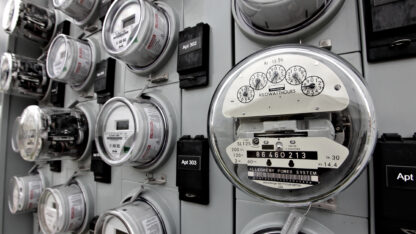Commission approves Georgia Power rate hike

This coverage is made possible through a partnership with WABE and Grist, a nonprofit, independent media organization dedicated to telling stories of climate solutions and a just future.
Georgia Power’s rates will increase over the next three years under an agreement approved by the state’s Public Service Commission Tuesday in a 4-1 vote. The first rate hike will hit January 1, 2023, but several more bill increases will follow.
In a statement, Georgia Power CEO Chris Womack applauded the plan for supporting the state’s energy needs while “balancing affordability needs for customers.”
“Through this process, we were able to bring forth a plan that considered all perspectives, manages the impact to customers and supports our continued focus on providing clean, safe, reliable and affordable energy to Georgians,” he said.
The state’s largest electric utility will collect $1.8 billion from ratepayers over the next three years, about a billion dollars less than the company had initially requested and a decrease of about 40 percent from the original request. The agreement reduces the requested budget for a power grid maintenance plan that experts called wasteful and expensive, the funding for a program to facilitate new electric vehicle charging and other operations costs.
The commission agreed to keep Georgia Power’s return on equity – or shareholder profits – nearly the same, instead of increasing that figure as the company had requested.
Lauren “Bubba” McDonald, the only commissioner to vote against the agreement, argued the utility should pocket less money.
“That’s a significant amount of revenues that the company will get that ratepayers will be paying,” he said.
More rate increases to come
Starting in January, the typical Georgia Power customer’s bill will increase by about $3.60 per month, far less than the $14.90 the company proposed. This difference is partially due to the overall reduction PSC staff negotiated, but it also reflects a change in how the three-year rate plan is structured.
Under the company’s original plan, the biggest rate hike – that $14.90 monthly increase – would have kicked in as of 2023, with smaller increases to follow in January 2024 and again in 2025.
The agreement approved on Tuesday instead follows a “step increase” approach that PSC staff championed. It means that January’s rate hike will be the smallest one, with greater increases to follow in each of the next two years.
Bills for residential customers will go up by about 2.8 percent in 2023. Come 2024, they will increase by about 4.5 percent of the 2023 rate; the following year, they will go up again by 4.5 percent of the higher 2024 rate. In other words, the rate hike will get bigger each year.
Staff pushed for this in large part because other rate increases are coming in 2023. When the first of two new nuclear reactors at Plant Vogtle goes online, currently projected to happen in the first few months of 2023, bills will automatically increase to help cover construction costs from the project. Georgia Power is also expected to request another rate hike to cover high natural gas costs.
Additional bill increases will come during the three-year lifespan of this rate agreement, including when the second new reactor at Plant Vogtle starts producing power.
Profit for the company
A major point of contention throughout the months of hearings has been the return on equity (ROE), or shareholder profit, that Georgia Power receives. Initially, the company sought to increase this figure – a request that drew particular ire from ratepayers and advocates facing inflation and a high energy burden. Former Democratic state senator Vincent Fort called it “price gouging.”
“Tell them they make enough profit,” Fort urged the commission in November. “Tell them that you are standing up for regular folk.”
Rates are set to give the company a certain ROE, known as the set point. But in reality, the company can earn above or below that figure; often, Georgia Power overearns. Within a certain range, known as the earnings band, the company gets to keep its profits. Above the band, it has to return some of the money to ratepayers.
In the end, the commission approved a set point of 10.5 percent, with an earnings band of 9.5 to 11.9 percent. It’s almost identical to the ROE in the 2019 rate order, when the top of the earnings band was 12 percent.
During Tuesday’s vote, Commissioner McDonald attempted to lower both the set point and the earnings band, pointing out that they’re substantially higher than the national average. His motions failed.
“We feel like the earnings are too rich,” said Southern Environmental Law Center senior attorney Jill Kysor after the vote. “It’s a very good holiday season for Georgia Power.”
Rooftop solar panel deal
The rate case also dealt with the billing for rooftop solar, an issue that advocates said could decide the fate of the industry in Georgia.
Most of the time, when someone installs solar panels on the roof of their home or business, they don’t get to unplug from the power grid entirely. When the sun is shining, the panels usually make more electricity than the customer can use, so they sell some energy to Georgia Power. And when it isn’t sunny, the rooftop solar customer needs to buy power.
Currently, Georgia Power pays rooftop solar owners a lower rate, known as “avoided cost,” for the excess power their panels make – currently about 2.68 cents per kilowatt-hour. When they buy power, those customers pay the utility the regular retail rate, which runs as high as 12 cents, depending on their usage and the time of year.
But the company briefly tried another system known as monthly netting, in which this buying and selling of power happens as a one-to-one exchange. It was a pilot program capped at 5,000 customers, and it proved so popular that it filled up quickly. Before the program, it took years for Georgia Power to reach 1,000 rooftop solar customers; the monthly netting pilot hit its 5,000-customer cap in just over a year.
Advocates say this shows that monthly netting is the way to get more rooftop solar in Georgia, a key component of the broader shift to renewable energy.
“Georgia Power is still way behind when it comes to its peers in rooftop solar adoption,” said Kysor. “Georgia might be a national leader when it comes to total solar installed, but almost all of that’s utility-scale.”
Instead of expanding monthly netting, the commission opted to attach an add-on rate of four cents to the current avoided cost rate – meaning Georgia Power will now pay about 6.68 cents per kilowatt-hour to buy customers’ excess solar energy.
A joint statement by the Southern Alliance for Clean Energy and Southface Institute slammed this decision as arbitrary, calling it “a result of back-room settlement negotiations; not a single expert in the case recommended the rate included in the final settlement.”
Kysor echoed that sentiment, noting that without expert testimony and evidence during the hearings, it’s difficult to predict the impact this rate will have on Georgia’s rooftop solar adoption and the solar installation industry here. She said her group and others will continue pushing the general assembly to expand monthly netting.
Electric vehicle infrastructure
Commissioners walked back one of the largest budget cuts proposed in the original agreement between their staff and Georgia Power: the company’s electric vehicle charging make-ready program.
This program helps businesses and public facilities install electric vehicle charging by making the necessary infrastructure improvements to support the chargers. Originally, the stipulated agreement between commission staff and Georgia Power called for the program to receive just 25 percent of the funding the company requested.
PSC staff argued the EV make-ready program mostly benefits EV owners and thus is not a public good. But several witnesses, especially from the public sector, pushed back on that idea. They argued that local governments seeking to electrify their vehicle fleets and public school districts switching to electric buses would need to install chargers.
“It’s proven essential to incentivize deployment of transformational EV charging technology,” said Commissioner Tim Echols at Tuesday’s hearing.
Echols proposed, and the commission approved, funding the make-ready program at 65 percent of Georgia Power’s original request. The agreement also prioritizes public sector uses for the make-ready program.
Meanwhile, questions about elections remain
Two of the five public service commissioners would have been up for election in November, but their races were put on hold by a federal court after civil rights advocates sued over the structure of PSC elections.
While the commissioners each have to live in a different Georgia district, they run statewide. The advocates argue that the arrangement illegally dilutes the power of Black voters. The state argues that the structure might favor Republicans, but that’s not evidence of racial discrimination.
A decision in the case is expected soon. If the advocates win, the Georgia General Assembly might have to redesign how PSC elections work in its upcoming session.








